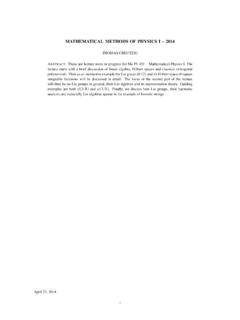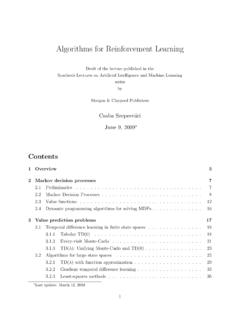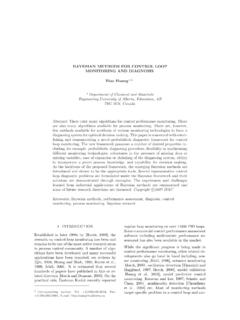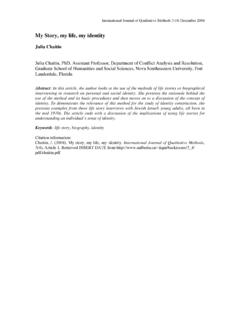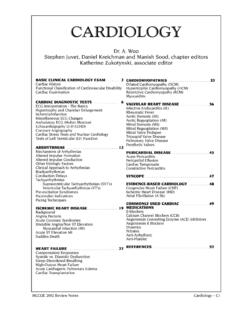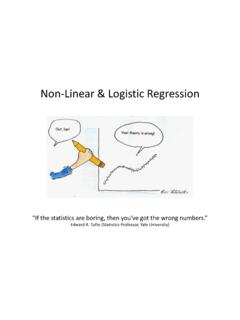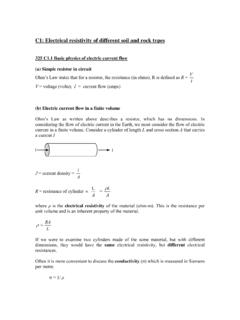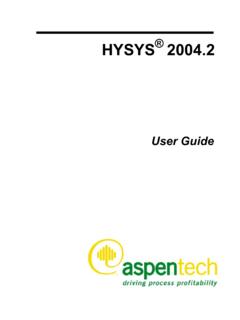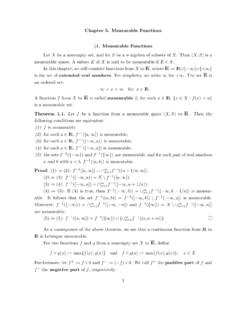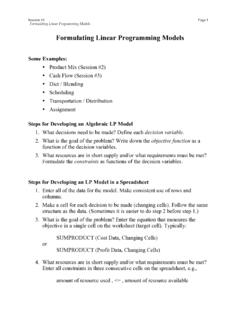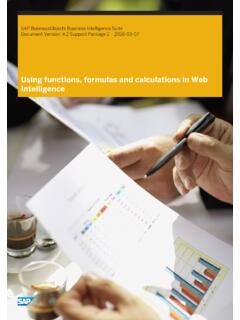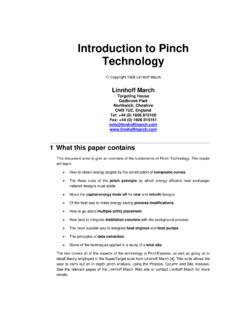Transcription of Excel Practice Spreadsheet - University of Alberta
1 EDIT202 Spreadsheet Lab Assignment Guidelines Getting Started 1. For this lab you will modify a sample Spreadsheet file named Starter- which is available for download from the Spreadsheet lab page on the course WebCT site. The link to this file is listed under the Needed Files section of the basic lab. Download this file to the computer (if you are working from lab on campus be sure to select Save As from the File menu and save it to a safe location that will not be deleted upon re-start). 2. Using Microsoft Excel create a marking Spreadsheet of a fictional class that meets the following guidelines. Name this file LABSEC-CCID- . To launch the Microsoft Excel program, locate the Microsoft Excel icon, and double click. To launch the program from the Start menu in the ED South 155 lab you can select Start > Programs > Microsoft Office > Microsoft Excel 2003. Once you have launched Microsoft Excel you should see the program interface with a blank worksheet labeled Workbook1.
2 Choose File > Open, then browse for the saved sample Spreadsheet that was downloaded from the course WebCT site. 3. You will need to make sure that the following toolbars are available in order to be able to complete all of the steps in the tutorial: Standard, Formatting, and Drawing Using the View menu choose Toolbars check of the name of a toolbar to add it to view. Worksheet 1. 4. Create columns to calculate the percent for each raw mark 4a. Insert a new column to the right of each Raw Marks column To insert a new column, left click inside any cell on the right side of where you wish the new column to appear (new columns are inserted to the left of the selected cell or column). Choose Insert > columns 4b. Enter Percent in the column header of each new column To enter information into a Spreadsheet , click the mouse on the cell where you want data to appear, then type. 4c. In the Percent columns , create a formula that will calculate the first student's percentage for that assignment or exam (Raw Mark / Marked Out Of).
3 Use relative and absolute cell referencing. In order to properly use formulas all formulas must start with an equal sign, =B5-B20. When typing in formulas, the formula should be typed where you want the result to be displayed. For example in the sample sheet below to calculate the first percentage the correct formula would be, =A2/B6 and the formula would be typed in cell B2. As an alternate to typing out each cell reference you can use your mouse. Once you begin a formula by entering an equal sign, then click your mouse on a cell you wish to use as a cell reference. You should notice that the cell reference is automatically entered into the formula. (This means when you are done your formula hit enter on the keyboard instead of clicking on another cell.). A relative cell reference is automatically adjusted when copying a formula to other cells. For example, if the following formula, = A1+B1 was copied, from cell C1 down to C2, the formula when copied would change to =.
4 A2+B2. An absolute cell reference refers to a value that does not change when being copied to other cells. For this example the same formula as above will be used but with one small change: absolutes will be added to the row values in the formula. In Microsoft Excel absolutes are represented as dollar signs, $). The absolute value in the percentage equation is the Marked Out Of value in cell B32. This is the value that each of the students' Raw Scores will be divided by. Using this information it will be up to you to think of where to place the absolute ($). 4d. Copy the formula down the column so that it determines the percentage for each student. To copy a formula, click on the bottom right-hand corner of the cell that needs to be copied and a little black crosshairs will appear. Drag down to include all the cells in the range. Release the mouse and we see our formula successfully copies with the correct results in our chosen cells.
5 4e. Format each students' percentage to be displayed in percent format and to include one decimal place ( not ). To get all of the numbers on your Spreadsheet displayed in a consistent manner, such as an equal number of decimal places, you need to set a number formatting option. To do this, first highlight the whole block of cells you want to format. The cells do not need data in them to complete this step; any data entered later will be formatted in this manner. You can then set the number of decimals in two ways: o Click once on the Increase Decimal button on the formatting toolbar. o The other way of adding decimals is to click on the Format menu, then click on Cells. Click on the Number tab, set the options as shown below, then click the OK button. In this window, the data can be formatted to look like currency with a $, or like percentages with a %. The results of our formulas or any other data can be formatted on our sheet to look like any type of data by selecting a different Category and setting different options.
6 5. Create a column to calculate the overall final mark for each student. 5a. In the column to the right of the Final Exam Percent column enter the column header Final Mark . 5b. Create a formula to calculate students' final weighted mark ((Assignment 1. Percent X Assignment 1 weight) + (Assignment 2 Percent X Assignment 2. weight) + .. + (Final Exam Percent X Final Exam weight)). 5c. Format the results for each student's final mark to be displayed in percent and to include one decimal place ( not ). 6. Create a new column to display if students received honors or not. 6a. In the column to the right of the Final Mark column enter the column header Honors . 6b. Insert a formula that will display an H in the Honors column if the student got a final mark that is equal to 80% or higher and will display an R if they did not get a mark over 80%. (Hint: you will want to use the IF function to do this). Note: Ensure that a mark of exactly 80% receives honors Some helpful symbols for you: > greater than < less than >= greater than or equal to <= less than or equal to If you have never used functions within Excel , it is recommended at this point that you go to the Functions section of your Prep Sheet read up on them.
7 To insert a function into a cell, click on the cell, then select Function from the Insert menu. This opens the Insert Function window. Choose the desired function, and click OK. If you can't find the function you are looking for select the All category and you will see all functions listed in alphabetical order. Your current assignment also makes use of the "IF" function, specifically to determine whether or not students will receive honors. The "IF" function is referred to as a conditional function. A conditional function can return different results based on a certain condition being evaluated to True or False. The "Logical_test" text box shown in the above screenshot is where you type the condition that will be evaluated. So if that condition proves to be True we can get it to return a certain result, and if that condition proves to be False then we can get it to return a different result. NOTE: The following is an example of using the IF function.
8 Refer to step 6b in the grey box above for the criteria you should use in this assignment. What is being tested in the example (please note this is only an example and will differ that what is needed for your assignment) shown below is whether or not the value in cell A5 is greater than 10 by typing "A5>10" in the "Logical_test" text box. So on the Spreadsheet the phrase, "Yes the number in A5 is more than 10", would appear in the cell we selected before opening the function wizard. If the value in cell A5 was less than 10 then the condition would be evaluated as "False", and the statement, "No the number in A5 is not more than 10" would appear in the cell we selected before opening the function wizard. 7. Sort the students on your Spreadsheet in ascending according to their ID. number. (Note: be sure that the students' data gets sorted along with the ID. numbers, otherwise you will mix up which marks go with which student).
9 First, indicate which data in the Spreadsheet is to be sorted. Select the range of data you want to sort, making sure that all the data you want to move as a result of the sort has been selected. Select Sort from the Data menu. The Sort options window appears. Choose either Header row or No header row, based on whether or not you included the column headings when you selected your sort data. Selecting the Header row option will in fact eliminate the top row of your sort data in an attempt to remove the column headings from your sort. From the Sort by drop down menu, choose which column you want to sort, then choose to sort it in Ascending or Descending order. Once finished, click on OK and view your sheet to make sure the data has been sorted correctly. 8. Bold the main title and change the font and size to Arial 24. Merge and Center the title across all of the columns containing data in the Spreadsheet .
10 9. Bold the individual column headings as well, and merge and center them across the two columns for each assignment and exam (raw mark and percent). To format the data on your sheet there are a few different options. First, select the cell or range of cells you want to format. You can use the available buttons on the formatting toolbar. You can also select Cells from the Format menu then select the Font tab to change the font size, style, or color. There are many more options when you use Format Cells, however using the formatting toolbar is quicker and more convenient. Merging cells is where you take a range of cells and merge them together as if they are one cell. An example of merged cells is shown below. Cells A1. through G1 of a sheet are merged (treated as if they were one cell), and the text is also centered within this larger cell area. To merge data we first need to select the cells we want to merge.
